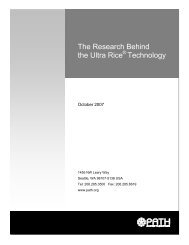Nepal Clean Home Delivery Kit: Evaluation of the Health Impact - Path
Nepal Clean Home Delivery Kit: Evaluation of the Health Impact - Path
Nepal Clean Home Delivery Kit: Evaluation of the Health Impact - Path
You also want an ePaper? Increase the reach of your titles
YUMPU automatically turns print PDFs into web optimized ePapers that Google loves.
It was not clear from <strong>the</strong>se data whe<strong>the</strong>r it would be worthwhile to include antimicrobials<br />
(antiseptics or antibiotics) in <strong>the</strong> kit to prevent infection. A study in Pakistan (Bennett et<br />
al, 1997) showed a significant protective effect against neonatal tetanus when<br />
antimicrobials were used both initially and in subsequent days, even when compared with<br />
a dry cord stump to which nothing had been applied. A similar study in Bangladesh<br />
(Parashar et al, 1998) found that only antibiotics (not antiseptics) applied at delivery were<br />
significantly protective against neonatal tetanus. There were not enough families using<br />
such substances in <strong>the</strong> current study to achieve statistically significant results, but Dettol<br />
and herbal treatments (mostly “harro”) had some protective effect. Antibiotics (used only<br />
by 17 households) showed no protective value (RR=1.1). There are not sufficient data<br />
here to support adding topical antimicrobials to <strong>the</strong> kit. It would be difficult to use <strong>the</strong> kit<br />
or <strong>the</strong> pictorial insert to promote <strong>the</strong> idea <strong>of</strong> putting nothing on <strong>the</strong> stump—leaving it<br />
uncovered.<br />
Disposal <strong>of</strong> <strong>the</strong> kit was generally done safely, with nearly 80% disposing <strong>of</strong> <strong>the</strong> blade and<br />
less than 8% keeping it without at least washing it. There should be little risk associated<br />
with reusing <strong>the</strong> plastic tarp (as about half <strong>the</strong> households did) since it was washed. About<br />
77% kept and reused <strong>the</strong> soap, which may contribute to improved personal hygiene in <strong>the</strong><br />
home. It may be necessary to caution people against using <strong>the</strong> soap on <strong>the</strong> newborns,<br />
since <strong>the</strong> field interviewers reported anecdotally that some families complained <strong>the</strong> soap<br />
was too harsh for babies.<br />
It is not possible to tell from <strong>the</strong>se data if <strong>the</strong> high level <strong>of</strong> use <strong>of</strong> new or boiled blades<br />
among kit non-users was related in any way to publicity about <strong>the</strong> kit or to general public<br />
education efforts about clean delivery. More information on how non-users knew to use a<br />
clean blade could be useful in developing awareness campaigns in o<strong>the</strong>r places not yet so<br />
well informed.<br />
Factors Related to <strong>Kit</strong> Use or Infection<br />
There were few major demographic differences between kit users and non-users, and<br />
nei<strong>the</strong>r demographic nor socioeconomic factors were strongly related to infection. This is<br />
consistent with <strong>the</strong> results <strong>of</strong> <strong>the</strong> 1996 <strong>Nepal</strong> Family <strong>Health</strong> Survey (Lu<strong>the</strong>r, Thapa,<br />
Westley, 1999), which found a limited effect <strong>of</strong> socioeconomic factors on neonatal<br />
mortality. Attendance at antenatal care seems to have contributed to increased kit use by<br />
giving people <strong>the</strong> opportunity to hear about kits from health workers. Although TT<br />
immunization was also correlated with antenatal care, it was not related to protection<br />
against simple cord infection (which fits with what would be expected).<br />
Although trained and untrained TBAs had differences in <strong>the</strong>ir practices, such as what <strong>the</strong>y<br />
put on <strong>the</strong> cord after and whe<strong>the</strong>r <strong>the</strong>y washed <strong>the</strong>ir hands before <strong>the</strong> delivery, both<br />
groups used a clean blade and cutting surface most <strong>of</strong> <strong>the</strong> time, and <strong>the</strong>re were no<br />
significant differences in infection rates between <strong>the</strong>m once <strong>the</strong>se specific factors were<br />
controlled for. The higher rate <strong>of</strong> infection associated with health workers, although not<br />
quite statistically significant, deserves fur<strong>the</strong>r investigation. It is not explained by hand<br />
29<br />
<strong>Nepal</strong> <strong>Delivery</strong> <strong>Kit</strong> <strong>Evaluation</strong> May 2000
















